Search
- Page Path
-
- HOME
- Search
- Review Article
- Infection
- Four months of rifampicin monotherapy for latent tuberculosis infection in children
- Chi Eun Oh, Dick Menzies
- Clin Exp Pediatr. 2022;65(5):214-221. Published online October 29, 2021
-
· Recently, the importance of a short-term treatment regimen including rifamycin has been highlighted in the treatment of latent tuberculosis infection (LTBI).
· Four prospective or retrospective studies in children consistently reported that a 4-month daily rifampicin regimen (4R) had a higher completion rate than and comparable safety to a nine-month daily isoniazid regimen.
· We suggest rifampicin 20–30 mg/kg/day for children aged 0–2 years and 15–20 mg/kg/day for children aged 2–10 years in 4R to treat LTBI.
- Correspondence
- General Pediatrics
- Letter to the editor: Age-, sex-, and height-based blood pressure reference charts, Yazd children 6-18 years, Iran
- Amar Taksande
- Clin Exp Pediatr. 2023;66(9):412-413. Published online October 27, 2021
-
- Original Article
- General Pediatrics
- Early initiation of breastfeeding and factors associated with its delay among mothers at discharge from a single hospital
- J. Jenifer Florence Mary, R. Sindhuri, A. Arul Kumaran, Amol R. Dongre
- Clin Exp Pediatr. 2022;65(4):201-208. Published online October 18, 2021
-

Background: According to the National Family Health Survey– 4, in India, 78.9% of deliveries occur in institutions, although only 42.6% of new mothers initiate breastfeeding within 1 hour of delivery.
Purpose: To estimate the proportion of early initiation of breastfeeding (EIBF) among new mothers at discharge from a tertiary care hospital and identify the determinants of delayed initiation of breastfeeding among...
- Review Article
- Neonatology (Perinatology)
- Pathophysiology, classification, and complications of common asymptomatic thrombocytosis in newborn infants
- Ga Won Jeon
- Clin Exp Pediatr. 2022;65(4):182-187. Published online October 18, 2021
-

· Thrombocytosis, common in newborns and infants (<2 years) (3%–13%), is caused by elevated thrombopoietin (TPO) concentrations.
· Serum TPO levels are significantly higher immediately to 1 month postnatal and decrease with age.
· Platelet counts are positively correlated with gestational age at birth and postnatal age.
· Thrombocytosis is more common in preterm than in term infants.
· Thrombocytosis in newborns is reactive and resolves spontaneously without complications.
- Endocrinology
- Genetic factors in precocious puberty
- Young Suk Shim, Hae Sang Lee, Jin Soon Hwang
- Clin Exp Pediatr. 2022;65(4):172-181. Published online October 18, 2021
-
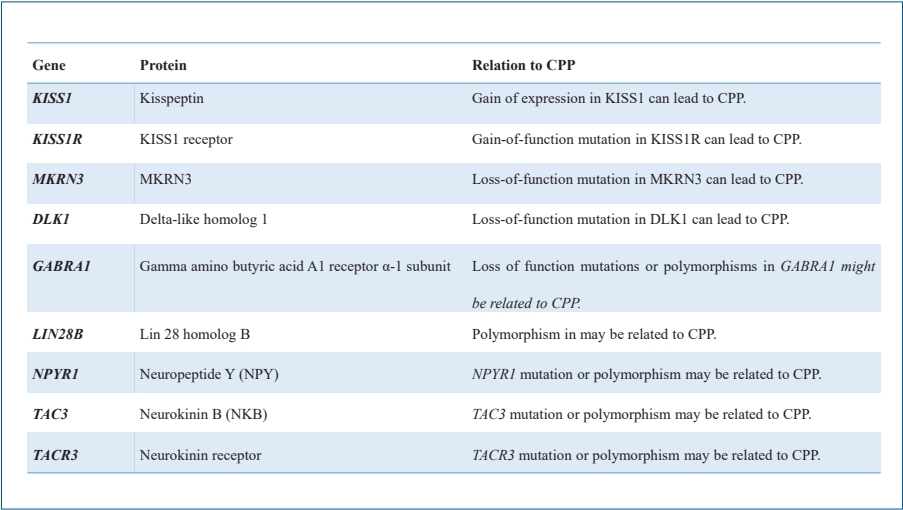
· Mutations in the kisspeptin (KISS1), kisspeptin receptor (KISS1R), makorin ring finger protein 3 (MKRN3), and delta-like homolog 1 (DLK1) genes are associated with idiopathic central precocious puberty (ICPP).
· A few genes related to pubertal onset have been implicated in ICPP.
· Epigenetic factors such as DNA methylation, histone posttranslational modifications, and noncoding ribonucleic acids may be related to ICPP
- Neonatology (Perinatology)
- Retinopathy of prematurity: a review of epidemiology and current treatment strategies
- Eun Hee Hong, Yong Un Shin, Heeyoon Cho
- Clin Exp Pediatr. 2022;65(3):115-126. Published online October 12, 2021
-

There have been global tri-phasic epidemic periods of retinopathy of prematurity (ROP). In recent years, its incidence has reportedly been 10%–40% depending on country and study population. Current treatment strategies for ROP include laser photocoagulation, surgical treatment, and anti-vascular endothelial growth factor treatment, the role of which has drawn attention in recent years.
- Editorial
- General Pediatrics
- Is it time to add point-of-care ultrasound education to pediatric residency curriculum?
- Shin Ae Yoon
- Clin Exp Pediatr. 2022;65(1):33-34. Published online October 12, 2021
-
Growing point-of-care ultrasound (POCUS) use in pediatric patients has led to the need for POCUS education for pediatric residents. Recent experimental studies have suggested that POCUS education improves self-rated POCUS confidence and comfort in pediatric resident training. Considering the effective and sustainable POCUS education curriculum in pediatric resident training, simulation-based education would be a solution.
- Original Article
- Infection
- Viral load and rebound in children with coronavirus disease 2019 during the first outbreak in Daegu city
- Mi Ae Chu, Yoon Young Jang, Dong Won Lee, Sung Hoon Kim, Namhee Ryoo, Sunggyun Park, Jae Hee Lee, Hai Lee Chung
- Clin Exp Pediatr. 2021;64(12):652-660. Published online October 12, 2021
-

Question: What is the natural course of viral load in children with coronavirus disease 2019 (COVID-19)?
Finding: A significant number of patients still had a relatively high viral load once clinically asymptomatic. Nearly half of the patients experienced viral rebound, which contributed to prolonged viral detection in their respiratory specimens.
Meaning: Further studies are needed to determine the clinical significance of viral rebound in asymptomatic or mild pediatric cases of COVID-19.
- Letter to the Editor
- Infection
- Multisystem inflammatory syndrome in children and Kawasaki disease in infants: 2 sides of the same coin?
- Hing Cheong Kok, Dinesh Nair, Ke Juin Wong, Siew Moy Fong
- Clin Exp Pediatr. 2021;64(11):599-601. Published online October 7, 2021
-
Question: Are multisystem inflammatory syndrome in children (MIS-C) and Kawasaki disease (KD) in infants, 2 sides of the same coin?
Finding: Here we report on a 4-month-old girl with MIS-C and signs of KD with shock. Most (83%) infants with MIS-C had features of KD, especially KD shock syndrome.
Meaning: MIS-C is similar to KD, and likely is a consequence of dysregulated immune responses secondary to sudden acute respiratory syndrome coronavirus 2 infection.
- Allergy
- Environmental and dietary factors to be checked for treatment of atopic dermatitis in rural children
- Sanghwa Youm, Eunjoo Lee, Jeongmin Lee
- Clin Exp Pediatr. 2021;64(12):661-663. Published online October 1, 2021
-
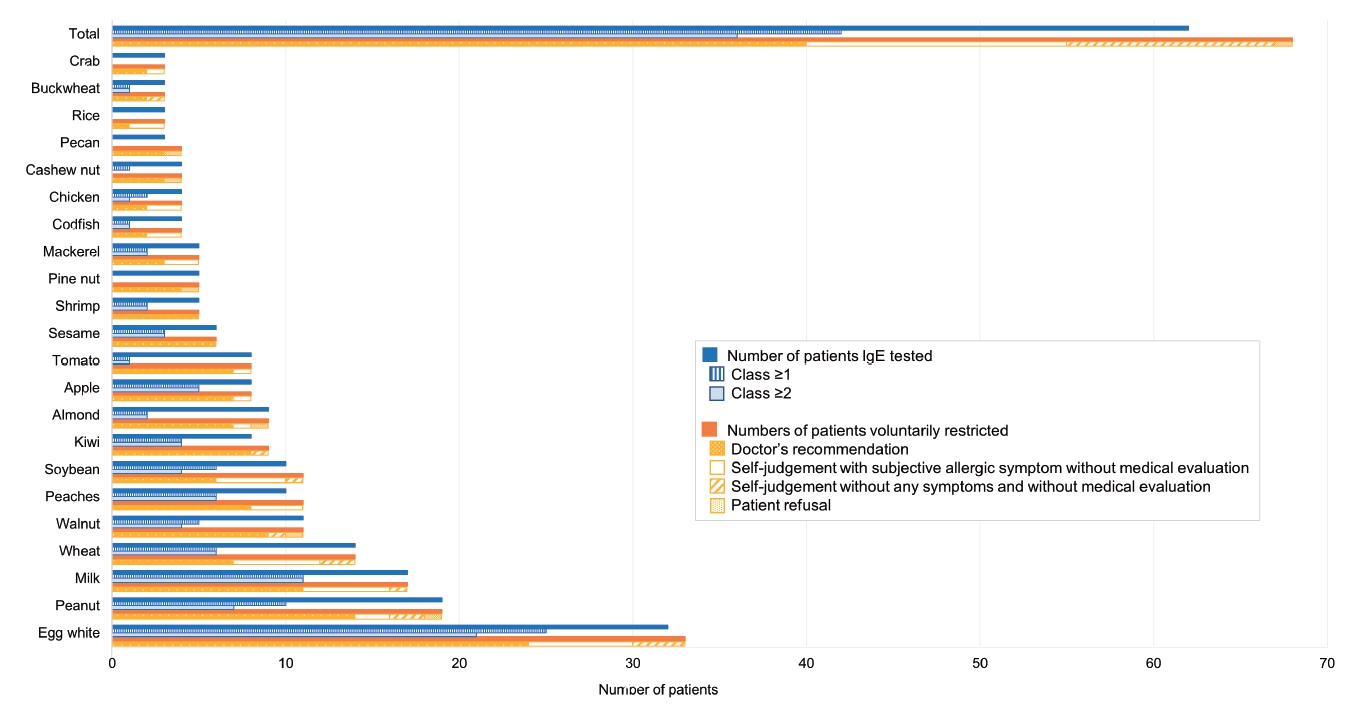
Question: What are the distinctive features of rural children with atopic dermatitis?
Finding: Birch and dog dander were the second most sensitized aeroallergens (32.6%), followed by house dust mites. Doctors and guardians reported food allergy comorbidities differently (19.9% and 43.5%, respectively). Dietary restrictions without medical evaluation were observed in 39.7% of patients.
Meaning: Effects of pollen distribution and indirect animal exposure should be evaluated. Evidence-based dietary restrictions must be implemented.
- Review Article
- Neurology
- Worldwide national intervention of developmental screening programs in infant and early childhood
- Seunghyo Kim
- Clin Exp Pediatr. 2022;65(1):10-20. Published online September 30, 2021
-

∙ Prevalence rate of developmental disabilities has been reported from 8% to 15% and its rate is increasing worldwide.
∙ The critical period of intervention for developmental delay is before the child reaches 3 years of age.
∙ All primary care pediatricians should conduct developmental surveillance and screening tests to infants and children at scheduled visits. Through this, they are liable for providing early identification and timely intervention.
- Editorial
- Neurology
- Recent studies are focus on the new treatments for hypoxicischemic encephalopathy (HIE) and long-term outcomes in later childhood and adolescence in children with a history on HIE
- Eun Sook Suh
- Clin Exp Pediatr. 2021;64(12):628-629. Published online September 30, 2021
-
Neonatal encephalopathy is the most important reason for morbidity and mortality. The early detection of neonate with high risk for hypoxic ischemic encephalopathy (HIE) and treatment are important for prevent long term complication. Hypothermia is currently standard treatment option for HIE. Several clinical studies have been performed due to improve the long term outcome. New therapeutic options including xenon, allopurinol, erythropoietin, topiramate will help to reduce neuropsychiatric disability.
- Original Article
- Neonatology (Perinatology)
- Is fetal nuchal cord associated with autism spectrum disorder? A meta-analysis
- Ensiyeh Jenabi, Maryam Ahmadi, Azam Maleki
- Clin Exp Pediatr. 2022;65(3):131-135. Published online September 24, 2021
-

Question: Is fetal nuchal cord a risk factor for autism spectrum disorder (ASD)?
Finding: Five articles (1 cohort, 4 case-control; total 3,088 children) were included in the present meta-analysis. Fetal nuchal cord was not a risk factor for ASD (odds ratio, 1.11; 95% confidence interval, 0.66–1.57). There was homogeneity among studies that reported a risk of ASD (I2=0.0).
Meaning: Fetal nuchal cord is not a risk factor for ASD.
- Review Article
- Infection
- Changes in age-specific seroprevalence of Japanese encephalitis virus and impact of Japanese encephalitis vaccine in Korea
- Byung Ok Kwak, Young Jin Hong, Dong Hyun Kim
- Clin Exp Pediatr. 2022;65(3):108-114. Published online September 24, 2021
-

Since the introduction of a universal Japanese encephalitis (JE) vaccination program and urbanization, the incidence of JE has dramatically decreased in Korea. However, recent JE cases have occurred, predominantly among unvaccinated adults and with a shift in age distribution. Continuous surveillance of the seroprevalence of JE is required to establish a proper immunization policy in Korea.
- Nephrology (Genitourinary)
- Blood pressure measurements and hypertension in infants, children, and adolescents: from the postmercury to mobile devices
- Seon Hee Lim, Seong Heon Kim
- Clin Exp Pediatr. 2022;65(2):73-80. Published online September 15, 2021
-

· Hypertension is defined as a blood pressure (BP) >90th (elevated) or 95th (hypertension) percentile in children by height, age, and sex and >95th percentile in neonates by age, birth weight, and sex.
· Although the oscillometric method can be used for screenings, the auscultatory method remains the gold standard. The hybrid method employs the auscultatory and electronic methods and can reduce bias.
· BP measurement mobile device applications have a potential for development.
- Gastroenterology
- Upper gastrointestinal tract involvement of Crohn disease: clinical implications in children and adolescents
- Eun Sil Kim, Mi Jin Kim
- Clin Exp Pediatr. 2022;65(1):21-28. Published online September 10, 2021
-

· Clinical manifestations of upper gastrointestinal (UGI) tract involvement in Crohn's disease (CD) are common but often clinically underestimated.
· Diagnosing CD by confirming inflammation of the UGI tract histologically is challenging because macroscopic and microscopic findings overlap with those of other diseases.
· Ongoing efforts are needed to enable a standardized assessment of UGI CD in the future.
- Clinical Note
- Infection
- A neonate infected with coronavirus disease 2019 with severe symptoms suggestive of multisystem inflammatory syndrome in childhood
- Fatemeh Eghbalian, Ghazal Sami, Saeid Bashirian, Ensiyeh Jenabi
- Clin Exp Pediatr. 2021;64(11):596-598. Published online September 10, 2021
-
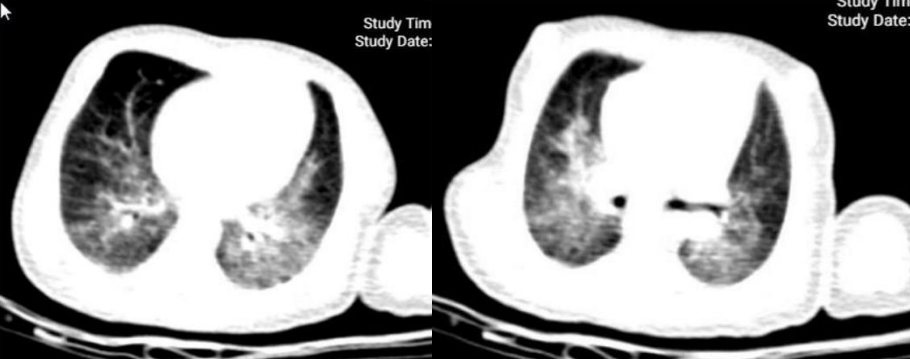
Question: Can multisystem inflammatory syndrome in childhood (MIS-C) occur in the neonate associated with coronavirus disease 2019 (COVID-19)?
Finding: A 9-day-old neonate infected with COVID-19 had fever, respiratory distress, and gastrointestinal symptoms suggestive of MIS-C. This neonate recovered after treatment with intravenous immunoglobulin (IVIG).
Meaning: IVIG successfully treated a rare case of a 9-day-old neonate with COVID-19 and severe symptoms suggestive of MIS-C.
- Original Article
- Emergency Medicine
- Nonfatal injuries in Korean children and adolescents, 2007–2018
- Gyu Min Yeon, Yoo Rha Hong, Seom Gim Kong
- Clin Exp Pediatr. 2022;65(4):194-200. Published online September 9, 2021
-

Question: How many children and adolescents have experienced nonfatal injuries in the previous year?
Finding: Among Korean children and adolescents, 8.1% experienced at least one injury per year. We found no significant change in the incidence of injuries over the previous 12 years.
Meaning: The incidence of injuries is higher than this estimation; therefore, more attention and effort are needed to prevent injuries among children and adolescents.
- Review Article
- Endocrinology
- Endocrine comorbidities of pediatric obesity
- Jieun Lee, Jae Hyun Kim
- Clin Exp Pediatr. 2021;64(12):619-627. Published online August 26, 2021
-
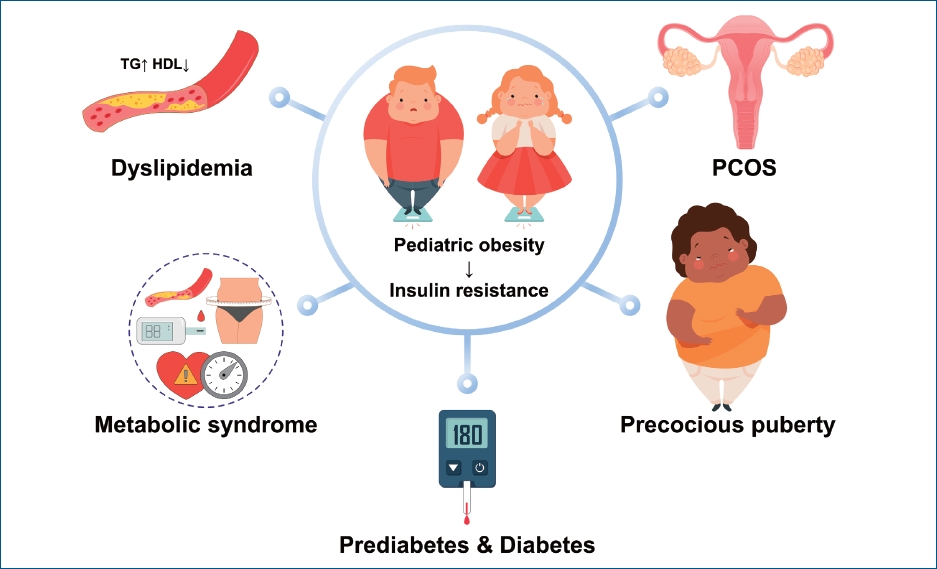
∙ Pediatric obesity can involve endocrine comorbidities such as prediabetes, type 2 diabetes, dyslipidemia, metabolic syndrome, polycystic ovary syndrome, and central precocious puberty.
∙ Prediabetes and type 2 diabetes in youth aged 10–19 years had a prevalence of 25.9% and 0.6% in 2013–2014, respectively.
∙ Dyslipidemia in Korean adolescents aged 10–18 years had a prevalence of 7.64% (total cholesterol ≥200 mg/dL), 6.09% (low-density lipoprotein cholesterol ≥130 mg/dL), 8.69% (triglyceride ≥150 mg/dL), and 12.52% (high-density lipoprotein cholesterol ≤40 mg/dL) in 2007–2018.
∙ Metabolic syndrome in Korean youth has a prevalence of 1.9%–14.7% in males and 1.7%–12.6% in females with wide variation in definitions.
∙ Appropriate comorbidity screening and management and/or specialist referral are necessary for obese children and adolescents.
- Neurology
- Promising candidate cerebrospinal fluid biomarkers of seizure disorder, infection, inflammation, tumor, and traumatic brain injury in pediatric patients
- Seh Hyun Kim, Soo Ahn Chae
- Clin Exp Pediatr. 2022;65(2):56-64. Published online August 23, 2021
-

· Pediatric cerebrospinal fluid (CSF) components have been extensively evaluated as biomarkers of various neurologic diseases.
· Several promising candidate CSF biomarkers, including Tau, glial fibrillary acidic protein, neuron-specific enolase, S100β, and interleukins, have been studied in pediatric patients with seizure disorders, central nervous system infections, inflammation, tumors, hypoxic-ischemic encephalopathy, traumatic brain injuries, intraventricular hemorrhage, and congenital hydrocephalus.
· Circulating microRNAs in the CSF are a promising class of biomarkers for various neurological diseases.
- Original Article
- Other
- Clinical spectrum and short-term outcomes of multisystem inflammatory syndrome in children in a south Indian hospital
- Muruganantham Balagurunathan, Thrilok Natarajan, Jothilakshmi Karthikeyan, Venkateshwaran Palanisamy
- Clin Exp Pediatr. 2021;64(10):531-537. Published online August 4, 2021
-
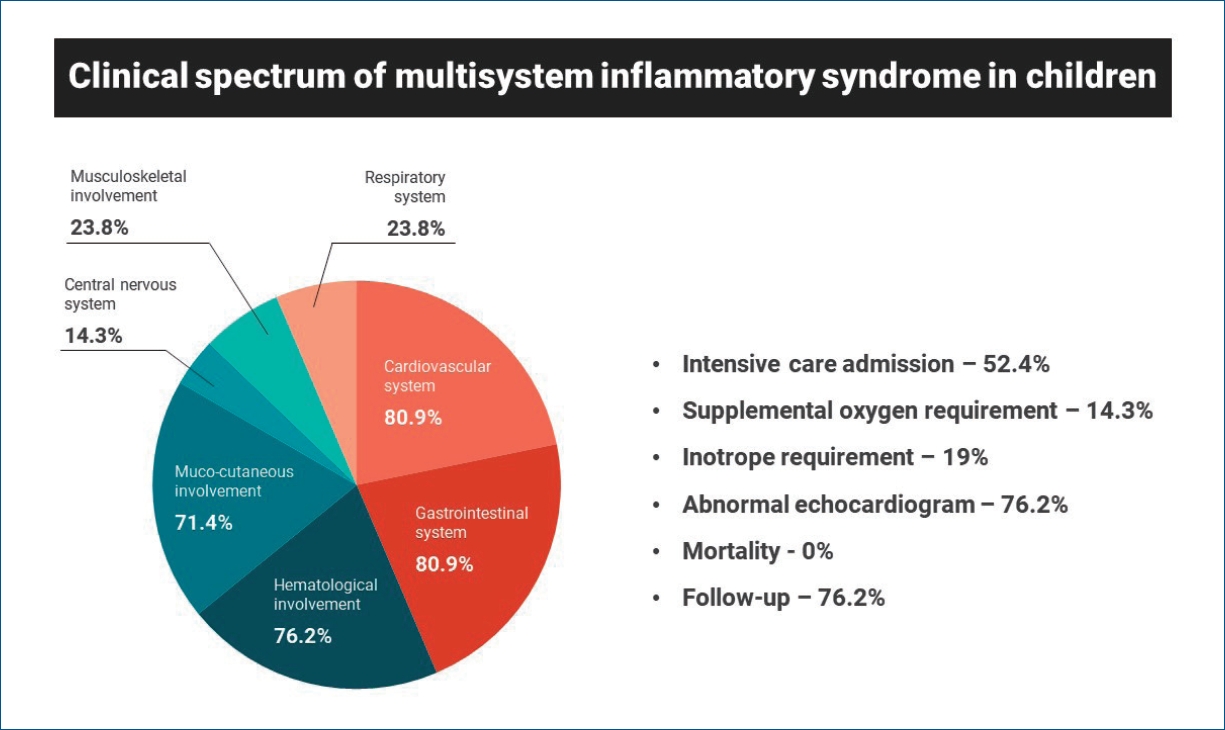
Question: What are the clinical spectrum, course, and short-term outcomes of multisystem inflammatory syndrome in children (MIS-C)?
Finding: MIS-C can have variable clinical manifestations. Fever is most common, followed by gastrointestinal and cardiovascular symptoms. Early identification and appropriate management lead to favorable outcomes.
Meaning: MIS-C can present in a myriad of ways and severities. High suspicion is necessary to ensure its early identification and appropriate management and favorable patient outcomes.
- Neonatology (Perinatology)
- Comparison of minimally invasive surfactant therapy with intubation surfactant administration and extubation for treating preterm infants with respiratory distress syndrome: a randomized clinical trial
- Mohammad Kazem Sabzehei, Behnaz Basiri, Maryam Shokouhi, Sajad Ghahremani, Ali Moradi
- Clin Exp Pediatr. 2022;65(4):188-193. Published online July 28, 2021
-
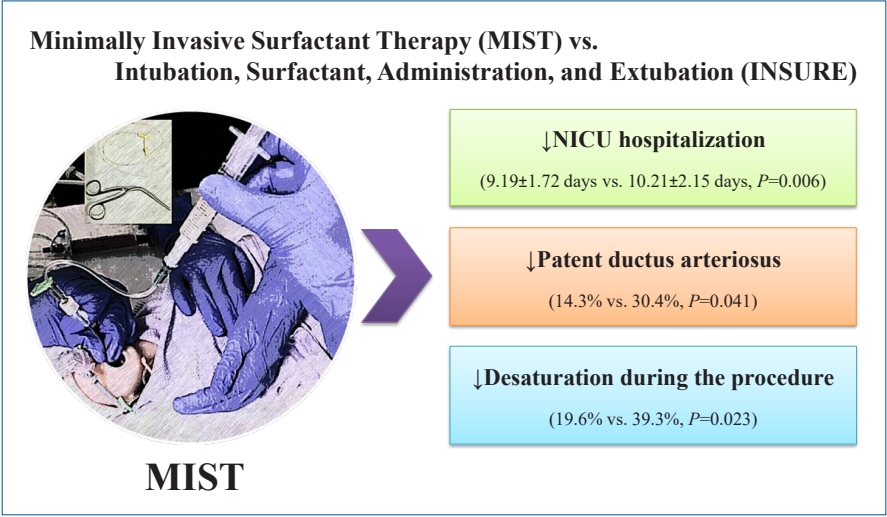
Question: Are the short-term outcomes of minimally invasive surfactant therapy (MIST) relatively superior to those of INtubation, SURfactant administration, and Extubation (INSURE) in preterm infants with respiratory distress syndrome (RDS)?
Finding: MIST could be an appropriate substitution for INSURE in preterm infants with RDS since it reduced hospitalization time and number of side effects.
Meaning: MIST is recommended for surfactant administration for its proven advantages over the INSURE technique.
- Letter to the Editor
- Other
- Evaluation of simulation-based ultrasound course for pediatricians: a starting point for future training curriculum
- Chon In Kuok, Avis Siu Ha Leung, Jonan Chun Yin Lee, Winnie Kwai Yu Chan
- Clin Exp Pediatr. 2022;65(1):53-55. Published online July 28, 2021
-
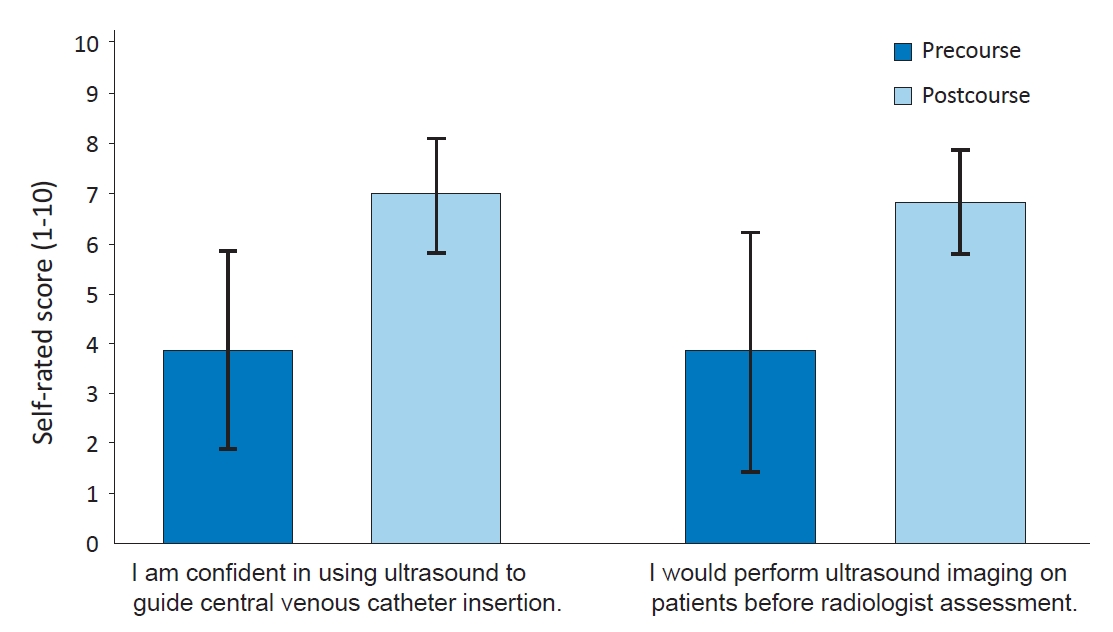
Question: Simulation-based ultrasound training is becoming more popular. Is there a role for pediatricians in such training programs?
Finding: Our program received promising feedback from its participants. Self-rated confidence in image interpretation and ultrasound-guided catheter insertion improved after the simulation. Participants reported a higher preference for performing ultrasound scans before radiologist assessment.
Meaning: Ultrasound training can be considered as part of the pediatric training curriculum in the future.
- Editorial
- Oncology
- Infantile hemangioma: timely diagnosis and treatment
- Meerim Park
- Clin Exp Pediatr. 2021;64(11):573-574. Published online July 22, 2021
-

While the majority of infantile hemangiomas (IHs) do not require therapy and regress spontaneously, about 10%–15% develop complications such as ulceration, obstruction, or disfigurement. Early intervention is recommended for infants with potentially problematic IHs. Oral propranolol 2–3 mg/kg/day is currently the treatment of choice.
- Review Article
- Neonatology (Perinatology)
- Growth patterns of preterm infants in Korea
- Joohee Lim, So Jin Yoon, Soon Min Lee
- Clin Exp Pediatr. 2022;65(1):1-9. Published online July 8, 2021
-
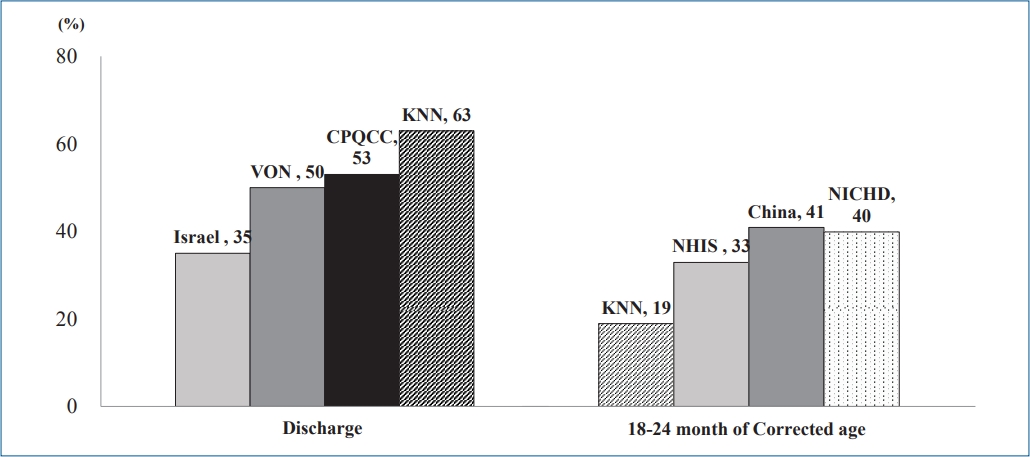
∙ The growth of preterm infants is a main focus of neonatology.
∙ Preterm infants in Korea, especially those with a very low birth weight, achieve retarded growth.
∙ Careful growth monitoring and early intervention will contribute to better development outcomes and quality of life for preterm infants and improve public health.
- Hematology
- Thrombosis and severe acute respiratory syndrome coronavirus 2 vaccines: vaccine-induced immune thrombotic thrombocytopenia
- Young Shil Park
- Clin Exp Pediatr. 2021;64(8):400-405. Published online June 30, 2021
-
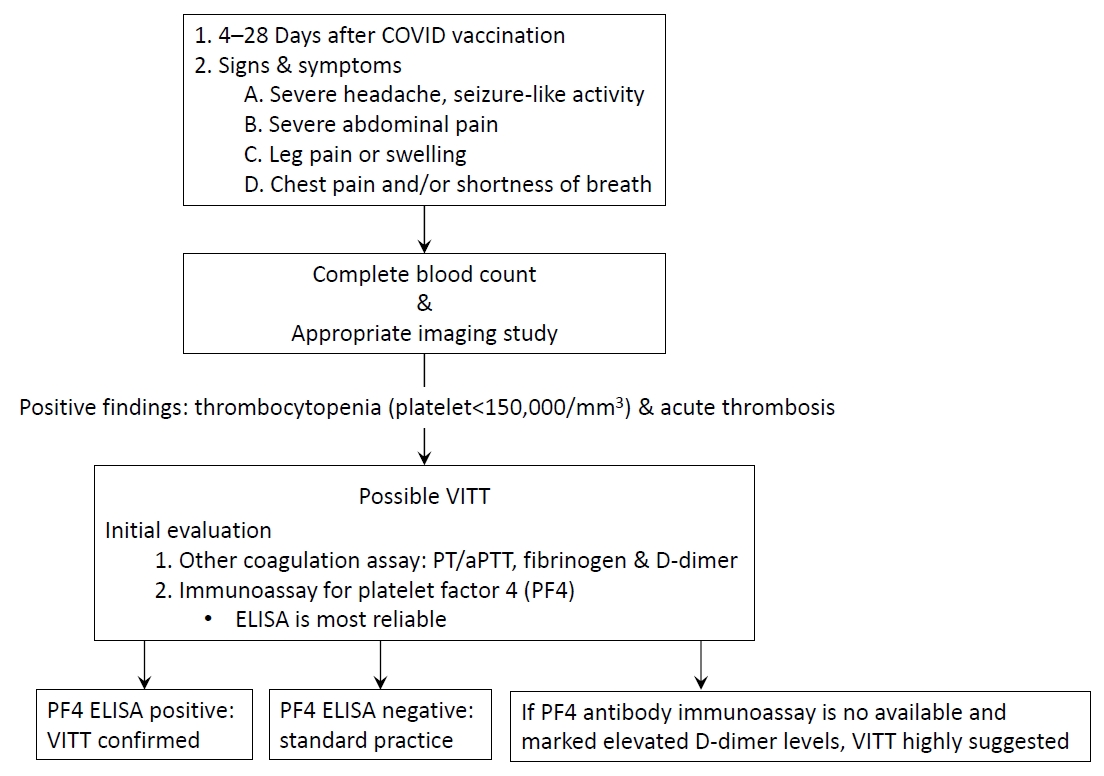
· Thrombosis and thrombocytopenia occurring within 4–28 days after severe acute respiratory syndrome coronavirus 2 vaccination require attention.
· The terms vaccine-induced immune thrombotic thrombocytopenia (VITT) and thrombosis with thrombocytopenia syndrome (TTS) are used.
· VITT is pathogenetically similar to heparin-induced thrombocytopenia.
· VITT/TTS could be associated with the development of platelet-activating anti-platelet factor 4 antibodies.
· For suspected VITT/TTS, early treatment decisions (intravenous immunoglobulin, non-heparin anticoagulant, and avoidance of platelet transfusions) are important.
- Infection
- Updates on the coronavirus disease 2019 vaccine and consideration in children
- Hyun Mi Kang, Eun Hwa Choi, Yae-Jean Kim
- Clin Exp Pediatr. 2021;64(7):328-338. Published online June 21, 2021
-
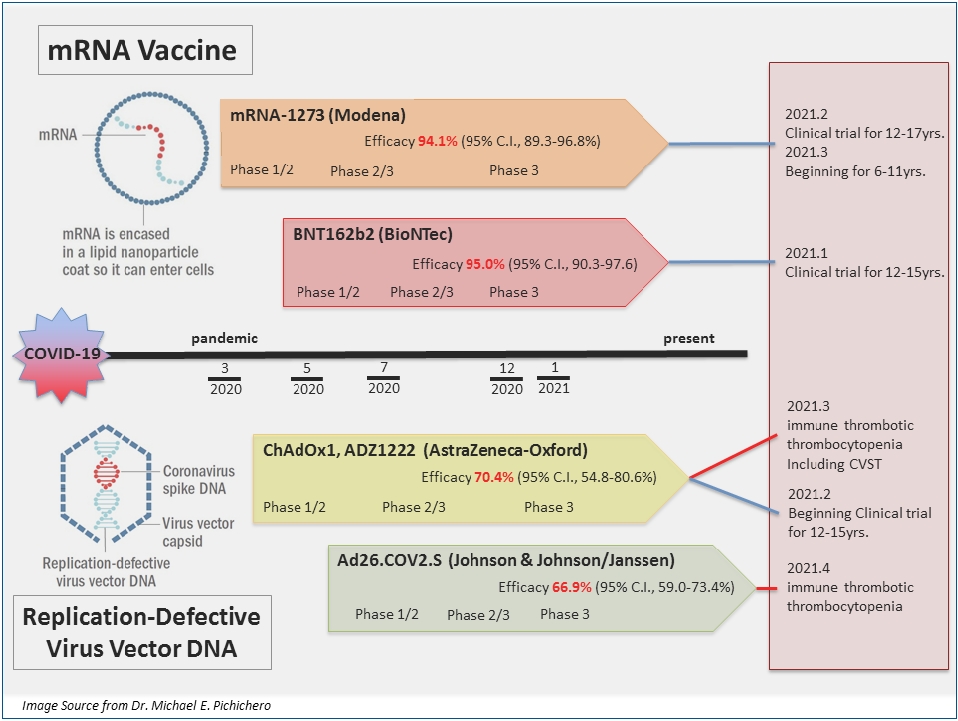
· The number of coronavirus disease 2019 cases has exponentially increased worldwide, and children ≤19 years old account for 11.0% of all confirmed cases.
· mRNA vaccines, BNT162b2 and mRNA-1273, and adenoviral vector vaccines, AZD1222 and Ad26.COV2.S, authorized for emergency use in the Emergency Use Listing of the World Health Organization are reviewed.
· Clinical trials of these vaccines have shown that they are safe and serious adverse reactions are rarely observed.
- Original Article
- General Pediatrics
- Gross motor dysfunction and balance impairments in children and adolescents with Down syndrome: a systematic review
- Preyal D. Jain, Akshatha Nayak, Shreekanth D. Karnad, Kaiorisa N. Doctor
- Clin Exp Pediatr. 2022;65(3):142-149. Published online June 11, 2021
-
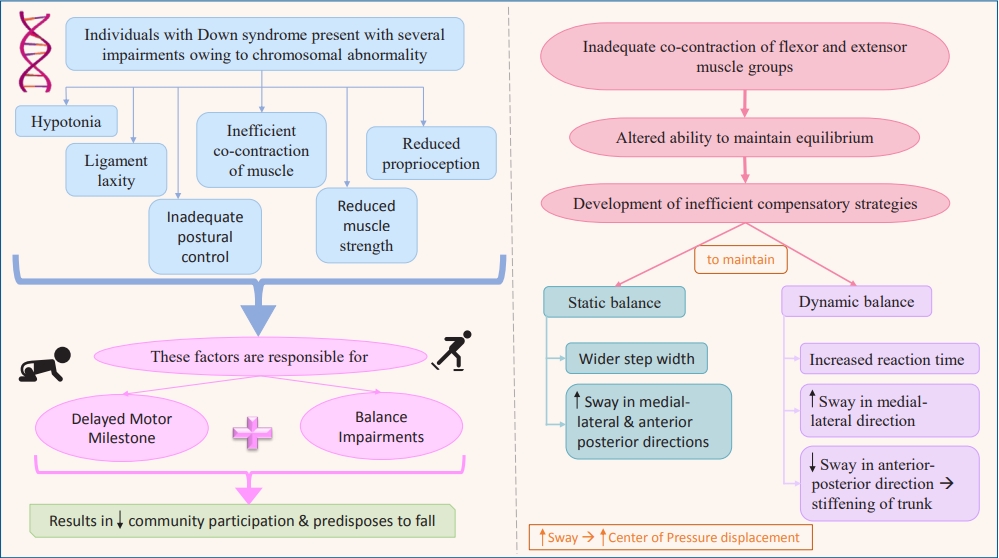
Question: What are the primary motor and balance dysfunctions in children with Down syndrome?
Finding: These individuals have gross delays, altered balance, and inefficient compensatory mechanisms.
Meaning: Neuromuscular and musculoskeletal impairments due to the chromosomal abnormality lead to developmental delay. These children also exhibit poor balance with greater instability and inefficient compensatory mechanisms including altered center of pressure displacement and trunk stiffening that predisposes them to falls.
- Editorial
- Other
- Global trend and disparity of acute lower respiratory infection as cause of mortality in children under 5 years of age
- Abdul Wahab
- Clin Exp Pediatr. 2021;64(12):630-631. Published online June 11, 2021
-
Acute lower respiratory infection (ALRI) is the leading cause of death among children under 5 years of age worldwide, especially in low- and middle-income countries. A spatial analysis explains the trends and severity based on the conditions of each country. Countries in Asia and Africa experience many cases of mortality caused by ALRI.
- Review Article
- Infection
- Recommendation for use of diphtheria and tetanus toxoids and acellular pertussis, inactivated poliovirus, Haemophilus influenzae type b conjugate, and hepatitis B vaccine in infants
- Hye-Kyung Cho, Su Eun Park, Yae-Jean Kim, Dae Sun Jo, Yun-Kyung Kim, Byung-Wook Eun, Taek-Jin Lee, Jina Lee, Hyunju Lee, Ki Hwan Kim, Eun Young Cho, Jong Gyun Ahn, Eun Hwa Choi; The Committee on Infectious Diseases of the Korean Pediatric Society
- Clin Exp Pediatr. 2021;64(12):602-607. Published online June 8, 2021
-
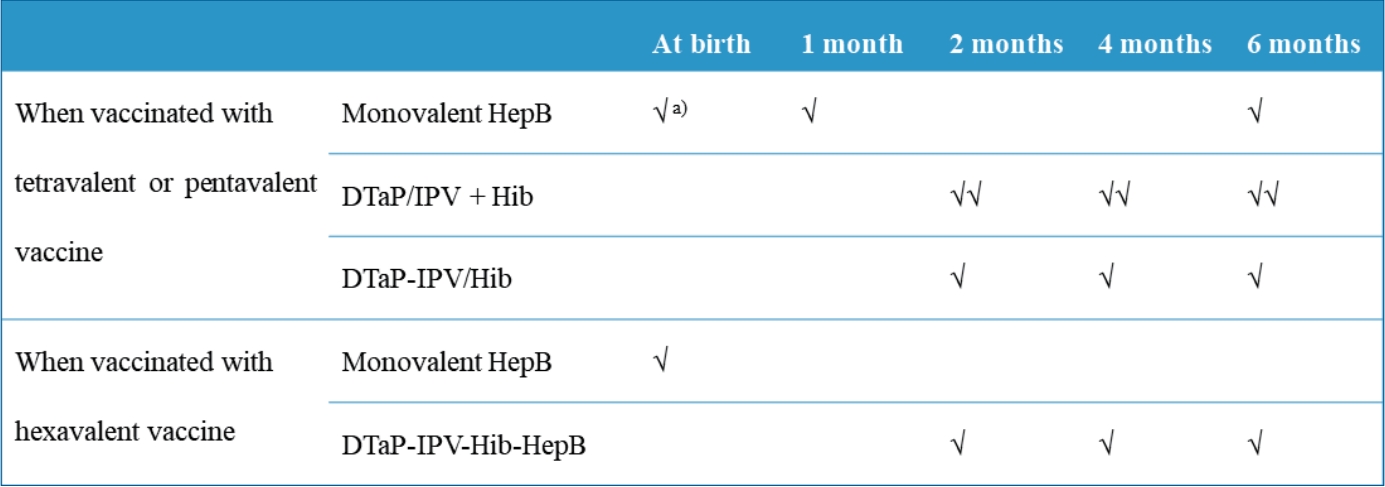
∙ Diphtheria and tetanus toxoids and acellular pertussis-inactivated poliovirus-Haemophilus influenzae type b-hepatitis B (DTaP-IPV-Hib-HepB) was licensed in Korea in April 2020.
∙ DTaP-IPV-Hib-HepB is indicated as a 3-dose primary series for infants aged 2, 4, and 6 months who received the standalone HepB vaccine at birth.
∙ Infants born to HepB surface antigen-positive mothers are currently recommended to be immunized with HepB immunoglobulin at birth and then monovalent HepB vaccine at 0, 1, and 6 months.
-

-
-
6.02024CiteScore98th percentilePowered by
-
Impact Factor3.6
-
- TOPICS
- ARTICLE CATEGORY
- Editorial Office
-
Korean Pediatric Society
#1606 Seocho World Officetel, 19 Seoun-ro, Seocho-ku, Seoul 06732, Korea
Tel: +82-2-3473-7306 Fax: +82-2-3473-7307 E-mail: office@e-cep.org
Clinical and Experimental Pediatrics is an open access journal. All articles are distributed under the terms of the Creative Commons Attribution NonCommercial License (http://creativecommons.org/licenses/by-nc/4.0/)
Copyright © 2025 by Korean Pediatric Society.











